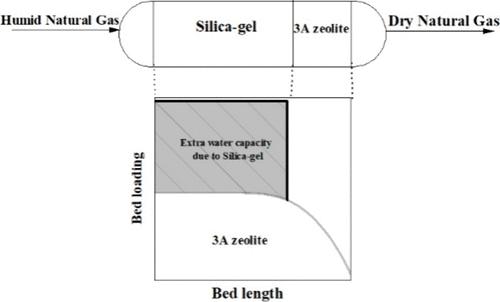Energy Improvement of Adsorptive Natural Gas Dehydration Unit by Layering the Bed
IF 3.9
3区 工程技术
Q2 ENGINEERING, CHEMICAL
引用次数: 0
Abstract
This work investigates the energy efficiency improvements achievable by a layered adsorption bed combining 3A zeolite and silica gel for natural gas dehydration via temperature swing adsorption (TSA). Simulation results indicate that extending the silica-gel bed relative to the zeolite layer enhances working capacity and cycle time. For an industrial-scale adsorption bed (3.5 m length, 5.5 m diameter) processing natural gas at a flow rate of 23929 kmol/h with an inlet water content of 1852 ppm, the dehydration cycle time was 760 min using a single 3A zeolite bed. By adopting a layered configuration with silica-gel and 3A zeolite layers at optimized lengths (3.7 and 1.8 m, respectively), the cycle time was extended to 1530 min. This adjustment reduced the number of annual cycles from 632 to 314. It decreased the energy consumption from 19.57 MJ/kg (of water removed) in the single-layer bed to 4.51 MJ/kg in the layered configuration. Additionally, the lower regeneration temperature required for silica gel (150 °C compared to 225 °C for 3A zeolite) contributes significantly to the energy savings. These findings emphasize the potential of layered adsorption beds in optimizing energy consumption and operational efficiency in industrial natural gas dehydration processes.

分层床法提高吸附式天然气脱水装置的能量
本文研究了3A沸石和硅胶相结合的层状吸附床通过变温吸附(TSA)对天然气脱水的能效提高。模拟结果表明,相对于沸石层,延长硅胶层可以提高工作能力和循环时间。对于工业规模的吸附床(3.5 m长,5.5 m直径),在流量为23929 kmol/h,进口水含量为1852 ppm时,使用单个3A沸石床脱水周期为760 min。采用优化长度(分别为3.7 m和1.8 m)的硅胶层和3A沸石层的分层配置,循环时间延长至1530 min。这一调整将年周期从632个减少到314个。它将能耗从单层床的19.57 MJ/kg(去除的水)降低到分层床的4.51 MJ/kg。此外,硅胶的再生温度较低(150°C,而3A沸石的再生温度为225°C),这大大有助于节能。这些发现强调了层状吸附床在优化工业天然气脱水过程的能耗和操作效率方面的潜力。
本文章由计算机程序翻译,如有差异,请以英文原文为准。
求助全文
约1分钟内获得全文
求助全文
来源期刊

Industrial & Engineering Chemistry Research
工程技术-工程:化工
CiteScore
7.40
自引率
7.10%
发文量
1467
审稿时长
2.8 months
期刊介绍:
ndustrial & Engineering Chemistry, with variations in title and format, has been published since 1909 by the American Chemical Society. Industrial & Engineering Chemistry Research is a weekly publication that reports industrial and academic research in the broad fields of applied chemistry and chemical engineering with special focus on fundamentals, processes, and products.
 求助内容:
求助内容: 应助结果提醒方式:
应助结果提醒方式:


